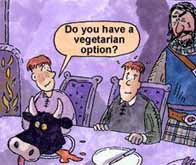Black Bull Dinner
 |
| The Earl of Douglas and his brother did not survive the meal (BBC
Cartoon)
|
Sir Alexander Livingston and Sir William Crichton, Keeper of
Edinburgh
Castle, who had recently
come to a power sharing agreement of sorts, were convinced that the Douglases, led by the
16 yeasr old, headstrong
William, 6th Earl of Douglas, were
enemies of the throne. They felt it necessary to crush the Douglases to
secure their own authority. Although it was fairly easy to secure
sufficient evidence to support a charge of high treason against the 6th
Earl of Douglas and his associates; it was an entirely different matter
to arrest this powerful baron in the midst of his own people in his own
castle.
It does not appear to have been difficult for Sir William
Crichton to lure the young earl from his castle, and to convince him to
present himself at the court of the boy king, James II in Edinburgh
Castle for a celebratory dinner of reconciliation. Thus, the 6th Earl of
Douglas, his younger brother David, and his advisor Sir Malcolm Fleming of
Cumbernauld arrived at Edinburgh Castle on November 24, 1440.
According to legend, a banquet was held in the Great Hall of Edinburgh
Castle, and the young James II was charmed with the company of the
Douglases. At the end of the feast, the head of a black bull was brought
into the hall. Under Scottish custom, this formality presaged the death
of the principal guest(s) at a dinner. James II is alleged to have
pleaded for the lives of his new friends to be spared, but they were
said to have been beheaded in front of the ten year old king.
However, Mr. E.B. Livingston suggests a more likely scenario on pages 43
and 44 of The Livingstons of Callendar, Edinburgh University Press,
1920:
"But what we do know for certain is that on the arrival of
the Earl of Douglas at the castle, he was at once arrested, together
with his only brother David, and his friend and counsellor Sir Malcolm
Fleming of Cumbernauld, who had accompanied him; that the three of them
were hastily tried for high treason, found guilty, and promptly beheaded
on the Castle Hill. The earl and his brother were executed on 24
November, 1440, and Sir Malcolm Fleming four days later.
The
Douglas clan then laid siege to Edinburgh Castle and Crichton perceiving the danger
surrendered the castle to the king and an uneasy truce was declared.
The later
execution must have been carried out contrary to the wishes of
Livingston, hence probably the four days' delay. For about three years
later, on 16 August 1443, Sir Alexander Livingston, in the presence of
Robert Fleming and four bishops, solemnly purged himself upon oath of
having given any counsel, assistance, or consent to the slaughter of Sir
Malcolm Fleming.
"Some of the old chronicle writers, who like
some modern journalists were not averse to inserting fictitious
picturesque details, so as to enliven their narratives, declare that the
Douglases were arrested while sitting at dinner, on the signal being
given by a black bull's head, supposed to be a sign of sudden death,
being placed on the table; and this fable, according to an old historian
of the House of Douglas, gave rise to the following doggerel rhyme:—
'Edinburgh castle, toun, and tower,
God grant ye sink for
sin;
And that even for the black-dinner,
Earl Douglas gat therin.'
"It is, however, highly improbable that either Livingston or
Crichton would have been parties to the introduction of such a
theatrical dénouement into this ghastly tragedy . . . ."
Following the demise of William, 6th Earl of Douglas and his brother at
the Black Dinner, William's great uncle James, known as "James the
Gross" became the 7th Earl of Douglas. Apparently, he had connived at
the execution of his nephew, and thus inherited the earldom and the
Douglas Estates. The lordships of Annandale and Bothwell fell to the
crown; Galloway to Margaret Douglas (William Douglas's sister).
Any contributions will be
gratefully accepted
Errors and Omissions
|
|
The Forum
|
|
What's new?
|
|
We are looking for your help to improve the accuracy of The Douglas
Archives.
If you spot errors, or omissions, then
please do let us know
Contributions
Many articles are stubs which would benefit from re-writing.
Can you help?
Copyright
You are not authorized to add this page or any images from this page
to Ancestry.com (or its subsidiaries) or other fee-paying sites
without our express permission and then, if given, only by including
our copyright and a URL link to the web site.
|
|
If you have met a brick wall
with your research, then posting a notice in the Douglas Archives
Forum may be the answer. Or, it may help you find the answer!
You may also be able to help others answer their queries.
Visit the
Douglas Archives Forum.
2 Minute Survey
To provide feedback on the website, please take a couple of
minutes to complete our
survey.
|
|
We try to keep everyone up to date with new entries, via our
What's New section on the
home page.
We also use
the Community
Network to keep researchers abreast of developments in the
Douglas Archives.
Help with costs
Maintaining the three sections of the site has its costs. Any
contribution the defray them is very welcome
Donate
Newsletter
If you would like to receive a very occasional newsletter -
Sign up!
Temporarily withdrawn.
|
|
|
|
|
|
|
|
|


